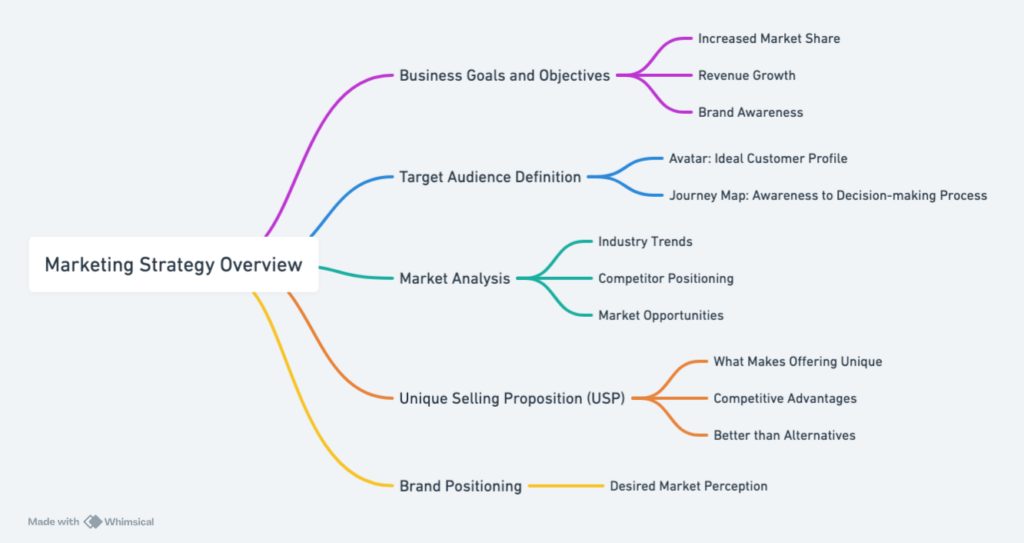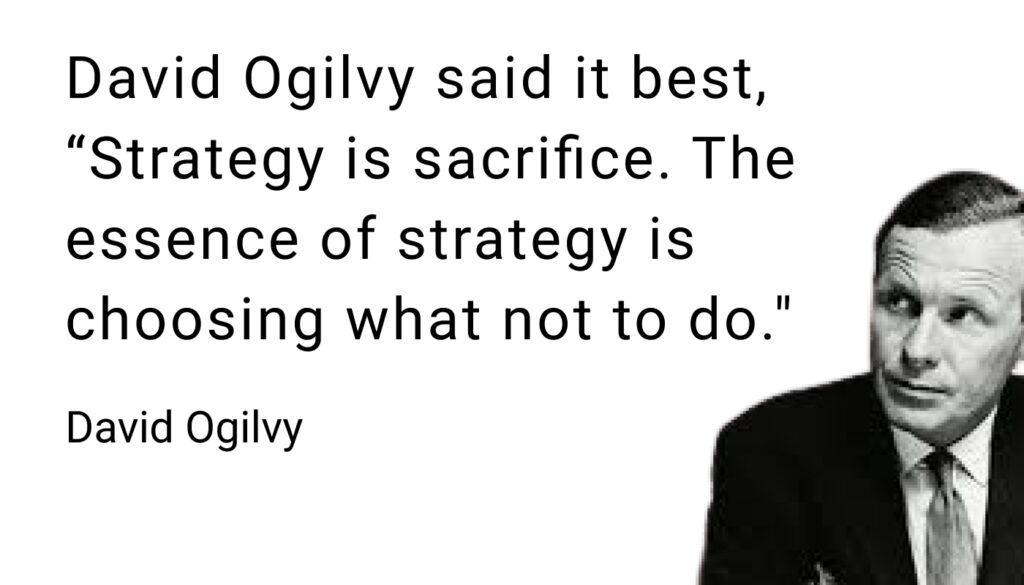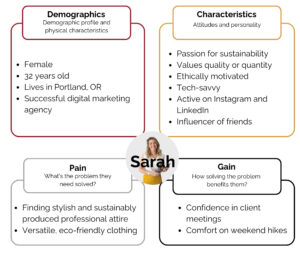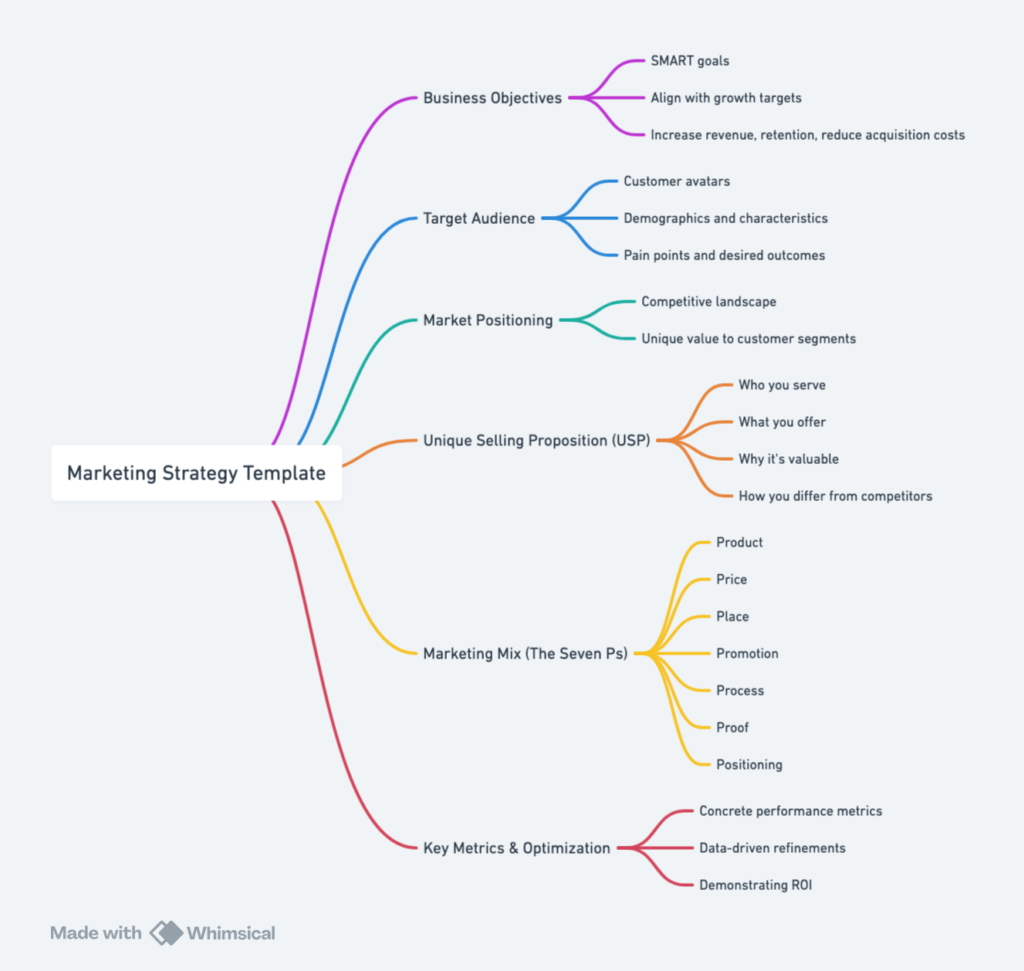Your cart is currently empty!

What is a Marketing Strategy and Why Do I Need One?
Reading Time: 21 minutesYou’re investing in marketing, but your growth has plateaued. Your website gets traffic, your social posts receive engagement, and you’re running ads—yet your revenue isn’t accelerating at the pace it should.
Sound familiar?
This frustrating reality is surprisingly common for businesses in the six- to seven-figure range. You’ve outgrown the scrappy marketing that got you here, but you haven’t yet built the strategic framework needed to scale to the next level.
Consider Early Bird Farms, a premium flour producer competing in a crowded market. Despite having an excellent product, their marketing efforts were fragmented and inconsistent—until they implemented a focused marketing strategy. Within weeks, not months or years, they saw a 150% increase in sales.
The key wasn’t working harder or spending more; it was developing clarity about who they were targeting and why.
Is your business operating without a marketing strategy?
Not sure what I’m asking?
Ask yourself:
- Do you understand who your best customers are?
- Do you know exactly which marketing activities generate the highest ROI?
- Can everyone on your team clearly articulate what makes your offering unique?
- Are you confidently saying “no” to marketing opportunities that don’t serve your audience or core business objectives?
If you hesitated on any of these questions, your marketing plan likely doesn’t include a marketing strategy. It’s the crucial piece separating businesses that break through growth plateaus from those that stagnate.
“Your strategy is defined not by what you say yes to, but by what you say no to.” ~ Steve Jobs

Breaking Through the Noise is Essential
With thousands of marketing messages bombarding consumers daily, businesses often struggle to break through the noise and engage their prime prospects. A marketing strategy helps you do this.
“So, what should I do? Do I need a marketing plan?”
“Yes, but an effective marketing plan has two parts: a marketing strategy and an implementation plan.”
This post is focused on marketing strategy because it is the backbone of your marketing plan. It’s what separates your efforts from the rest. A strategy determines why your marketing breaks through the noise. And more often than not, it’s missing.
“OK, I get it. An effective marketing plan has two parts. How are they different?”
Each side has a focus. The marketing strategy focuses on the ‘who’ and the ‘why.’ The implementation plan focuses on the ‘how’ and the ‘when.’ If all you have is the implementation plan, you contribute to the noise. You break through the noise when you use the marketing strategy to build the implementation plan.
In this post, you’ll discover what a marketing strategy entails, why it’s non-negotiable for sustainable growth, and describe a practical framework for developing one that delivers measurable results. Whether you’re looking to refine your current approach or build a strategy from scratch, you’ll walk away with actionable insights specifically designed for businesses at your stage.
Let me give you an example of strategy in action.
When Toyota launched the redesigned teardrop-shaped Prius, nationwide dealerships marketed it as “good for the environment” because it was a hybrid. But, in Northern California, the agency I worked for took a different approach. We dug deeper into who the target customer was and what truly motivated them. Instead of the environmental angle, we positioned the Prius as “an economical family car because it was a hybrid.”
The result?
Northern California dealers sold more Priuses than the rest of the country combined. Same car, same features—but a completely different strategy based on customer insights. That’s the power of marketing strategy.
Ready to transform your marketing from tactical noise to strategic success? Let’s explore what a marketing strategy is and how to build one that delivers measurable results for your business.
Table of Contents
What is a Marketing Strategy?
A marketing strategy is a comprehensive, forward-looking document that outlines how a business will reach its target audience (who) and defines how it solves its customers’ problems (why). It focuses on the ‘who’ and ‘why.’ Having a marketing strategy focuses the marketing plan, the ‘how’ and ‘when.’
Hopefully, by now, you can see that a marketing strategy is not a plan. They are both necessary, but they aren’t the same. The strategy gives the plan its backbone.
Understanding the ‘who’ and ‘why’ is key to breaking through the digital noise.
It’s also key to transitioning from scrappy growth to marketing that can scale. Without a strategy, everything in your marketing plan is equally important. With a strategy, you are better equipped to allocate resources, something that’s crucial when every dollar needs to generate a result.
Without a strategy, implementation decisions rest with the business owner. With a strategy, the marketing team or agency can implement the plan without the owner’s involvement, which removes a growth bottleneck.
While you should read this post to understand what a marketing strategy is, it may make sense for you to hire a fractional CMO. They will have deep experience with marketing strategy development, and the ROI on an investment in a fractional CMO can be substantial—often delivering enterprise-level strategic expertise at a fraction of the cost of a full-time executive.
Elements of a Marketing Strategy
An effective marketing strategy includes several key elements. As you review what they are, note the order in which they are presented. The order matters.

- Business goals and objectives – What you want to achieve through your marketing efforts (increased market share, revenue growth, brand awareness).
- Target audience definition—who your audience is and what they want to achieve. This has two parts: the avatar and the journey map. The avatar describes your ideal customers, and the journey map describes their journey from no awareness to decision-making and beyond.
- Market analysis – Research on industry trends, competitor positioning, and market opportunities.
- Unique selling proposition (USP) – The USP combines the definition of the target audience and market analysis. It defines what makes your offering unique, competitive, and better than alternatives.
- Brand positioning – How you want your brand to be perceived in the marketplace.
These elements work together to create a cohesive approach to attracting and converting customers.
How a Marketing Strategy Differs from an Implementation Plan
Many business owners conflate marketing strategies with implementation plans. They are related but serve different purposes:
| Marketing Strategy | Implementation Plan |
| Long-term vision and direction | Short-term tactical execution |
| Focuses on “who” and “why” | Focuses on “how” and “when” |
| Delivers the business objectives | Details specific actions and timelines |
| Typically spans 1-3+ years | Usually covers 3-12 months |
| Supports market positioning | Lists campaigns and content calendars |
As strategy expert Roger Martin explains, “Most strategic planning has nothing to do with strategy. Planning focuses on controllable resources and costs, while strategy specifies a desired competitive outcome.” In other words, your marketing plan is the list of actions, while your strategy is the competitive advantage you’re trying to create.
Strategic vs. Tactical Approaches
The distinction between strategic and tactical thinking in marketing is crucial.

- Tactical thinking asks: “Are we doing things right?” It’s about executing activities efficiently.
- Strategic thinking asks: “Are we doing the right things?” It’s about making choices on where to play and how to win.
While this post is focused on marketing strategy, you need both. First, you determine your strategic position in the marketplace—how you’ll differentiate yourself from competitors and provide unique value to a specific segment of customers; the who and why. Then, you develop tactics to deliver on that strategy; the how, and when.
Efficiency is doing things right; efficacy is doing the right things.~ James’ism
Michael Porter, the father of modern strategy, said, “competitive strategy is about being different.” Your marketing strategy should define how your business will stand out, not how you promote your products or services.
In the next section, we’ll explore why having a well-defined marketing strategy is essential for business success, especially in today’s noisy, competitive landscape.
Why Your Business Needs a Marketing Strategy
A properly executed marketing strategy gives you business-critical advantages that sporadic marketing activities simply can’t deliver. When I audit campaigns and websites, the most common problem I see is an absence of strategy. Your competition likely doesn’t have a strategy, so if you do, then you have the upper hand.
Direction and Focus
A marketing strategy forces you to make deliberate choices about where to invest your resources for maximum impact. Without a strategy, everything is the same, and businesses often fall into the trap of chasing every marketing trend and opportunity. They waste resources, time, and treasure by spreading themselves too thin.

By clearly defining your target audience and messaging, a marketing strategy helps you concentrate your efforts where they’ll generate the greatest returns rather than diluting your impact across too many initiatives.
Resource Optimization
Marketing budgets are finite, no matter the size of your business. A strategic approach ensures your financial and human resources are allocated efficiently.
Consider the following:
- According to Gartner’s CMO Spend Survey, marketing budgets have declined, emphasizing the need for efficient strategies.
- McKinsey’s MROI diagnostics suggest optimizing marketing spend can yield significant savings and revenue growth.
- Forrester’s research highlights the importance of minimizing waste in marketing efforts to improve ROI.
Businesses without clear marketing strategies often waste between 20% to 60% of their marketing budgets on ineffective tactics and misaligned messaging. In contrast, companies with well-defined marketing strategies typically experience improved ROI due to more efficient resource allocation and targeted efforts.
When you understand precisely who you’re targeting and why they make purchasing decisions, you can focus your investment on the channels and messages that actually reach and engage them. This minimizes wasteful spending and maximizes your marketing dollar’s impact.
Competitive Advantage
A thoughtful marketing strategy helps you carve out a unique position in your market. This differentiation is crucial for standing out among competitors offering similar products or services.
Your strategy should articulate your unique value proposition—what makes your offering distinctly valuable to customers. By consistently reinforcing your differentiation in all your marketing efforts, you build a competitive advantage that’s difficult for others to overcome.
For example, IKEA doesn’t compete on price or quality alone; its marketing strategy positions it as an affordable, well-designed furniture provider that improves home life. This strategic positioning has created a distinct market space where they thrive.

FedEx offers another powerful example of strategic positioning through clear customer benefits. When they launched their iconic campaign, “When it absolutely, positively has to be there overnight,” they didn’t focus on explaining their innovative hub-and-spoke logistics system to CFOs and COOs. Instead, they highlighted the specific outcome that mattered most to their primary decision makers—executive assistants and office managers who needed reliability above all else.
This customer- and benefit-focused positioning created a distinct competitive advantage by addressing the prime prospect’s emotional need for certainty and peace of mind. This allowed FedEx to command premium pricing and build extraordinary customer loyalty. The strategy worked because it translated complex operational capabilities into a simple, compelling promise that resonated with the target audience’s core concerns.
Measurable Outcomes
Without a strategy, marketing success is subjective and difficult to evaluate. When I defined the components of a marketing strategy, the Objective was the first thing. A proper marketing strategy establishes clear goals and key performance indicators (KPIs) that allow you to track progress objectively.

Strategic Measurement Transforms Marketing from Cost Center to Growth Engine
These measurable outcomes serve multiple purposes:
- They provide accountability for marketing investments
- They help identify which tactics are working and which aren’t
- They inform data-driven adjustments to improve results
- They demonstrate marketing’s contribution to business growth
When you can measure results against strategic objectives, marketing transforms from a cost center to a growth driver with provable ROI. When we support our clients, we never guess—we measure everything and use data to refine in near real time.
Adaptation to Market Changes
Markets evolve constantly—new competitors emerge, customer preferences shift, and technologies transform how people use media and buy and consume products and services. Rather than reacting haphazardly to market developments, a strategic approach allows you to evaluate changes through the lens of your longer-term goals, making thoughtful adjustments while maintaining overall direction.
This balance between consistency and flexibility is critical. As Roger Martin notes, “Strategy is a journey, not a fixed plan. What you want to have is a mechanism for tweaking it, honing it, and refining it so it gets better and better as you go along.”
Can Marketing Strategy Impact Your Business?

You may have heard about McDonald’s menu changes. The headlines describe how McDonald’s removed the dollar sign from its prices. McDonald’s did this and more.
I’m including this here to demonstrate how adjustments, even on a portion of the strategy, can impact your business. In this McDonald’s example, you’ll see how the strategy-driven changes in how they communicated price in-store impacted their business.
What Happened at McDonald’s
- Menu Restructuring: McDonald’s moved prices below item descriptions. This change encourages customers to focus on the product’s appeal before considering the cost.
- Visual Enhancements: They increased the size of item photos by 40%, which can stimulate stronger cravings and reduce rational price considerations.
- Social Proof: Customer favorites were highlighted, leveraging social proof to influence purchasing decisions.
- Prioritization of Best-Sellers: Top-rated items were positioned at the top of menus, guiding faster decisions and reducing price sensitivity.
- Symbols matter: they removed the dollar sign from the price to soften the impact.
Why It was Smart Marketing
- Psychological Impact: Removing or minimizing the dollar sign reduces the psychological barrier of spending money. Seeing currency symbols can trigger brain regions linked to physical pain, making consumers more cautious about spending.
- Focus on Value Over Price: By presenting prices less prominently, customers are more likely to focus on the product’s value and appeal rather than its cost.
- Enhanced Customer Experience: The changes aim to create a more immersive experience in which customers are drawn to the product’s features and benefits rather than deterred by the price.
This approach aligns with broader marketing strategies emphasizing a positive customer experience (who) and subtly influencing consumer behavior (why) to increase sales and brand loyalty.
But, did it work?
McDonald’s attributed a 9.5% increase in sales in 2023 to these strategic changes.
Sources: The ScaleUp Newsletter and The Blueprint.
Key Components of an Effective Marketing Strategy
Creating a marketing strategy that actually works requires several essential components working together. Let’s break down these key elements that form the foundation of successful marketing strategies.
Target Audience Definition
A deep understanding of who you’re trying to reach is at the core of any effective marketing strategy. This goes far beyond basic demographics to include psychographics, pain points, and aspirations.
The Customer Avatar

The customer avatar (or buyer persona) is a detailed profile of your ideal customer that helps you understand:
- Their demographics
- What they’re like
- The problems they’re trying to solve
- What they hope to achieve
The more specific your customer avatar, the more targeted and effective your marketing becomes. Many businesses make the mistake of trying to appeal to everyone, resulting in generic messaging that doesn’t resonate with anyone.
“Effective marketing repels the wrong audience as fiercely as it attracts the right one.” ~ James’ism
Remember that you likely have multiple customer segments, each requiring its own avatar. Determining your key segments is key, but don’t get crazy.
The Pareto Principle should be used when analyzing business revenue. Look closely at your customers, and you will see that most of your revenue (80%) comes from a minority of your customers (20%). Your specific number will be unique to your business, but the concept is valid. Your highest-value customers—those who spend the most, stay the longest, and refer others—deserve special attention in your marketing strategy. The others shouldn’t be ignored, but your ROI will be limited.
Even the best advertising will not change a consumer’s need state. ~ James’ism
The other side of this coin is the buyer’s journey map.
The Buyer’s Journey Map
If your customer avatar is the “who,” and the “why,” that’s the foundation of your marketing strategy, then the buyer’s journey map is the “how” and the “when” that you use to build the implementation plan.

Creating accurate buyer’s journey maps is often the biggest obstacle—and equally the biggest missed opportunity—in marketing.
That’s why we developed Marketing Sage Advantage, which uses guided customer interviews and a custom GPT to produce data-backed avatars and journey maps.
Marketing Sage Advantage ensures you’re not guessing who your audience is or what they need or when they want it.
Since the journey map is more important to the implementation plan, we won’t spend more time on it now. We’ll publish another post about it soon.
Market Research and Analysis
Strategic marketing decisions should be based on and supported by solid research, not assumptions. This includes:
Competitor Analysis: Study what your competitors are doing well and where gaps exist in their offerings. This isn’t about copying their approach but finding opportunities to differentiate your business.
Market Trends: Identify shifts in customer behavior, emerging technologies, and evolving industry standards that could impact your marketing effectiveness.

SWOT Analysis: You can identify opportunities and threats by combining the insights from the competitor analysis and the market trends analysis with your strengths and weaknesses. A SWOT gives you a clear picture of your company’s position in the marketplace.
Good research prevents costly missteps and highlights opportunities that might otherwise go unnoticed. It also provides validation (or correction) for your strategic assumptions before you invest significant resources.
Brand Positioning
Brand positioning defines how you want your company to be perceived relative to competitors. It’s the unique space you aim to occupy in your customers’ minds.

Positioning is a powerful force. In the early days of personal computing, Apple’s Lisa was technologically superior—boasting a graphical user interface and mouse support long before its time. Yet IBM’s marketing and entrenched reputation in the business world led companies to perceive the IBM PC as the more “professional” choice. In effect, IBM positioned Apple’s product as better suited for the home or creative environments, a perception that proved difficult for Apple to shake.
Even a brilliant product can be sidelined without the right positioning strategy; it took Apple decades of strategic pivots to reclaim significant ground in the business market.
Effective positioning articulates:
- Who you serve (target audience)
- What you offer (product/service category)
- How you’re different (key differentiators)
- Why customers should care (benefits)
Your positioning should be distinctive, relevant to your target audience, and defensible over time. It guides everything from visual identity to marketing messages and channel selection.
“In a crowded marketplace, fitting in is a failure. In a busy marketplace, not standing out is the same as being invisible.” ~ Seth Godin
Another example is how Volvo has built its brand position around safety, while BMW focuses on performance and driving experience. Both sell cars, but they’ve created unique positions in the market that attract different customer segments.
Then, compare Volvo and BMW to Tesla. Tesla’s current momentum rides on EV hype rather than a deeper positioning—like Volvo’s safety or BMW’s performance. As more automakers release electric models, Tesla risks losing its edge without a clear, lasting market position.
Value Proposition
Your value proposition is a clear statement that explains:
- How your product/service solves customers’ problems
- What specific benefits can customers expect
- Why customers should buy from you instead of competitors
An effective value proposition informs everything in your business and your marketing. It must be specific, address real customer needs, and be delivered consistently. It becomes the centerpiece of your marketing messages and helps you break through the noise.
When crafting your value proposition, focus on the outcomes customers will experience, not just the features of your offering.
Don’t sell the journey, sell the destination. ~ James’ism
People don’t buy products or services—they buy the results and experiences those products or services provide.
The Marketing Mix
The marketing mix—often called the 4Ps or 7Ps—defines the tactical building blocks of your strategy:
- Product: The goods or services you offer, including features and design.
- Price: Your strategic approach to valuing those offerings.
- Place: Where and how customers find and buy from you.
- Packaging: The presentation that shapes first impressions, whether physical or digital.
- Promotion: The methods you use to inform and persuade your target audience.
- People: Those who create and deliver the customer experience (crucial for service businesses).
- Positioning: The unique space your brand occupies in the market and customers’ minds.
Your marketing mix should align with your strategic positioning and value proposition. For example, a premium positioning requires pricing, packaging, and promotional tactics that reinforce that premium image.
Each of the Ps is an opportunity to optimize your marketing strategy. I already described how McDonald’s used the pricing P to drive growth. Oatly’s packaging changes demonstrate how the packaging P can be used as a growth driver.

In 2014, facing competition in the alt-milk category, Oatly completely revamped their packaging with:
- Custom typography and conversational copy that engaged consumers directly
- Bold color schemes that broke from traditional dairy-inspired designs
- Unconventional layouts that transformed packaging into a storytelling medium
Oatly’s revamped packaging strategy helped drive remarkable growth. The same product was in a different container, and revenues reached $643.2 million by 2021 and have climbed to $813 million in recent years.
Each element of your marketing mix offers similar opportunities to create a competitive advantage through strategic choices that align with your positioning and resonate with your target audience.
Goals and KPIs
You can’t measure success or optimize your marketing efforts without clear goals. Effective marketing strategies include:
- Strategic objectives: What you want to achieve (e.g., increase market share, enter new markets)
- Specific goals: Measurable targets tied to those objectives (e.g., grow email list by 5,000 subscribers, increase conversion rate by 20%)
- Key performance indicators (KPIs): Metrics that track progress toward goals (e.g., website traffic, lead conversion rate, customer acquisition cost)
These elements create accountability and provide feedback on whether your strategy is working. They also inform necessary adjustments when results don’t meet expectations.
Well-defined KPIs transform marketing from a creative function into a business growth driver with measurable impact. When setting your metrics, focus on outcomes (results directly impacting business growth) rather than outputs (marketing activities completed).
What a Marketing Strategy Looks Like
A marketing strategy is the overarching game plan that defines how a business will reach its ideal customers and position itself in the market to drive sustainable growth. It provides direction for all marketing activities and ensures alignment between business objectives and customer needs.
As I mentioned above, a marketing strategy is not an implementation plan. The strategy is the why and who behind the marketing; the plan is the how and when. The strategy ensures that every marketing dollar spent moves the business toward its long-term goals.
I’ll create a concise summary of the marketing strategy template section to use in its place.
Marketing Strategy Template: The Essential Framework
While a comprehensive marketing strategy requires detailed planning, the core framework includes six essential elements.

1. Business Objectives
Set SMART goals that align marketing efforts with business growth targets, such as increasing revenue, improving retention, or reducing acquisition costs.
2. Target Audience
Develop detailed customer avatars that capture demographics, characteristics, pain points, and desired outcomes to ensure that marketing resonates with your ideal customers.
3. Market Positioning
Clearly articulate where your business fits in the competitive landscape and how you deliver unique value to your chosen customer segments.
4. Unique Selling Proposition
Define your USP to communicate who you serve, what you offer, why it’s valuable, and how you differ from competitors in a compelling, memorable way.
5. Marketing Mix (The Seven Ps)
Align your Product, Price, Place, Promotion, Process, Proof, and Positioning to create a cohesive approach that supports your strategic objectives.
6. Key Metrics & Optimization
Establish concrete metrics to measure marketing performance, enabling data-driven refinements and demonstrating ROI.
For a detailed template with examples and implementation guidance, watch for our upcoming post: “The Complete Marketing Strategy Template for Business Owners.”
Getting Real About Marketing Strategies
A marketing strategy is more than a document—it’s a blueprint for growth. And as I’ve said before, the most common problem I see when I audit websites and digital marketing campaigns is an absence of strategy.
Stop shouting; start supporting. ~ James’ism
Business owners who take the time to understand their audience, clarify their positioning, and set measurable objectives are better equipped to use marketing to scale their business profitably. By following this template, you can ensure every marketing activity aligns with your business goals rather than operating on guesswork.
Common Marketing Strategy Mistakes to Avoid
A marketing plan has many inputs. As mentioned above, the marketing strategy is the most important input and the area where mistakes are made. To help you avoid predictable traps when developing marketing strategies, here are some of the common mistakes we see all the time.
No Clear Goals
Setting vague objectives like “increase brand awareness” without specific targets leads to unfocused efforts and makes success impossible to evaluate. Instead, establish SMART goals with concrete metrics and timeframes.
Ignoring Data and Analytics
Creating strategies based on assumptions rather than evidence often leads to misaligned marketing. Let data inform your decisions by surveying customers, analyzing traffic, and tracking performance metrics.

Inconsistent Messaging
When your brand voice or value proposition changes across channels, you confuse customers and dilute impact. Develop clear brand guidelines and ensure all marketing maintains core themes while adapting to different platforms.
Failure to Adapt
Markets evolve, but many businesses cling to outdated approaches. Implement quarterly strategy reviews to evaluate performance data and make necessary adjustments while maintaining your core positioning.
Inside-Out vs. Outside-In Marketing
Focusing on your features rather than customer needs misses the mark. Shift to an outside-in approach that begins with understanding customer pain points and how they make decisions.
Overlooking the Competition
Developing strategies in a vacuum leaves you vulnerable. Conduct thorough competitive analysis to identify unique positioning opportunities and anticipate market responses.
For an in-depth exploration of these marketing strategy pitfalls and detailed solutions, watch for our upcoming post: “8 Marketing Strategy Mistakes That Are Costing You Customers.”
How to Measure Marketing Strategy Results
A marketing strategy without proper measurement is merely a set of assumptions. Measurement turns assumptions into results, allowing you to optimize performance and demonstrate clear return on investment.
With measurement in place and a means to easily monitor performance, usually a measurement dashboard, you can see what’s working great, what’s doing OK, and what needs a closer look. Without measurement, you’re guessing, and this isn’t an efficient path to profitability. Bluntly, measurement is the key to optimizing digital marketing.
Setting Up Proper KPIs
Successful measurement begins with selecting the right key performance indicators (KPIs). These metrics should directly connect to your strategic objectives and provide meaningful insight into performance.
Strategic Objective Alignment
Different strategic goals require different metrics:
- For brand awareness objectives: Track metrics like brand search volume, social media mentions, and aided/unaided recall in surveys
- For lead generation objectives: Measure new leads, lead quality scores, cost per qualified lead, and cost per conversion
- For conversion objectives: Focus on conversion rates, customer acquisition cost, and average order value
- For retention objectives: Monitor customer lifetime value, repeat purchase rates, and churn metrics
The most effective measurement frameworks combine leading indicators (early signals of success or problems) with lagging indicators (final results). This combination allows you to make adjustments before final outcomes are determined.
Beware of Vanity Metrics
Avoid the trap of emphasizing metrics that look impressive but don’t connect to business outcomes. Examples include:
- Raw page views without engagement metrics
- Social media followers without interaction rates
- Email list size without open or click rates
These vanity metrics can create the illusion of success while masking underperformance in areas that actually drive revenue.
Tools for Tracking
Modern marketing offers powerful tracking tools to measure nearly every aspect of your strategy’s performance. The key is creating an integrated measurement system rather than isolated data points.
Essential Tracking Infrastructure
For most businesses, a basic measurement stack includes:
- Website analytics, use Google Analytics and Google Search Console to track user behavior, traffic sources, and conversion paths
- Email marketing platform (Mailchimp, ActiveCampaign) to measure engagement with nurturing campaigns
- Social media analytics (native platform tools, Sprout Social) to track reach and engagement
- Survey tools (SurveyMonkey, Typeform) to gather qualitative feedback and brand perception data
A CRM system (Pipedrive, HubSpot) might be useful, especially with B2B marketing, but I don’t think it’s essential.
UTM Tracking Implementation
Proper campaign tracking is essential for understanding which marketing efforts drive results. We recommend that our clients use UTM parameters to track each website visitor’s source, medium, and campaign.
As we explain in our post “Want to Increase Marketing Effectiveness? How UTM Codes Can Help,” a consistent UTM structure helps you track campaigns across platforms and understand which channels deliver the highest-quality traffic and conversions. This granular tracking enables more informed budget allocation and strategy refinement.
Case Study: Crafting a Customer-Centric Marketing Strategy

The Challenge
Early Bird Farm & Mill (EarlyBirdNC.com) offers premium stone-ground organic flour in a booming domestic market worth over $200 million. Despite the product’s quality, their inconsistent marketing and product-centric messaging failed to resonate with customers, leading to underwhelming sales.
The Approach
Using our outside-in approach to marketing rather than Early Bird’s inside-out approach, we began by defining Early Bird’s target audience with detailed avatars.
Broadly, all prime prospects were looking for high-quality flour to bake with that produced nutritious baked goods. Digging deeper, we uncovered what beginning home bakers and experienced artisans sought: practical recipes and scientific proof of the flour’s quality, respectively. Armed with these insights, we launched a strategic redesign of their website and developed a marketing campaign.
For the website, rather than shouting “Buy Now,” we created “people-like-you” pathways, one for beginners and one for artisans. Each pathway invited visitors to explore baking tips and recipes designed for them.
We built out the recipe blog and added links from the recipes to the ideal products. We also added a recipe tab to the product listings that linked to appropriate recipe posts and a tab where scientific data was shared.
Finally, we complemented the refreshed site with updated marketing materials, including an email marketing strategy and a tailored Pinterest campaign, targeting prime prospects and guiding them through the buyer’s journey.
In this case study, you can see how we applied the two strategy documents, the avatar and the journey map, to create a marketing strategy and plan. Who and why led to how and when.
The Result
This outside-in approach quickly paid off. Within weeks, Early Bird saw a 150% increase in online sales compared to the previous year. More importantly, their audience began to see Early Bird as a trusted resource, not just a flour supplier—a testament to the power of a customer-centric marketing strategy.
Another insight you can gain from this is that you don’t need to fix everything. We focused on a few areas and saw an almost immediate improvement. As the business improves, we’ll look at other areas.
We started by understanding the ideal customers. What matters to them? How do they process/look for information? This helped us understand who the best prospects were. We then redesigned their marketing and website to attract prime prospects and support their journey.
For example, understanding what information they needed pointed us to Pinterest, a channel that fits the audience’s interests in recipes.
Finally, we increased the price across the board to better match the premium product the mill is producing.
Four things and the increase in sales was immediate and continues to grow.
Chart Your Course to Sustainable Growth
“Strategy without tactics is the slowest route to victory. Tactics without strategy is the noise before defeat.” – Sun Tzu
Why a Marketing Strategy Is Non-Negotiable
At the six to seven-figure revenue stage, marketing complexity increases exponentially. You’ve likely achieved success through some combination of great products, personal relationships, and tactical marketing, but that same approach isn’t scaling with your growth ambitions.
If you read this and have gotten this far, chances are your growth has slowed or stalled, and you are looking for a solution.
I get it.
For businesses in your revenue bracket, ineffective marketing isn’t just frustrating—it’s expensive. Our clients typically discover they’ve wasted 30-40% of their marketing budget on activities that aren’t driving growth. That’s a boatload of cash that could be fueling their expansion.
A marketing strategy isn’t another expense; it’s the framework that transforms scattered marketing activities into a cohesive system that delivers predictable results as you scale. It eliminates the guesswork that becomes increasingly costly at your business stage.
How does this happen?
The process of creating your marketing strategy forces clarity:
- It requires you to understand your customers and their needs deeply
- It demands that you articulate what makes your business truly different
- It pushes you to make intentional choices about where to focus your resources
- It establishes measurable goals that keep your efforts accountable
Most of our clients implement their new strategy within 60 days and see measurable improvements within the first quarter. Early Bird Farms didn’t need years to see results—they achieved a 150% sales increase within weeks through strategic focus on four key areas.
Remember that your marketing strategy isn’t a static document. It should evolve as your business grows, as customer needs change, and as you gather more data about what works. Even McDonald’s, a global leader with decades of experience, recognized this when they revised their menu pricing strategy: removing dollar signs, repositioning prices, and highlighting customer favorites. They believe this strategic shift contributed to a 9.5% sales increase in 2023. The most successful businesses treat their marketing strategy as a living framework that guides decisions while remaining flexible enough to adapt to new opportunities and challenges.
Your action item isn’t to overhaul everything at once. Start by downloading our quick-start guide and complete just the customer avatar exercise. This single clarity point has helped businesses like yours identify immediate opportunities to redirect marketing investments for better returns.
Quick Start Guide
Click the button below to access our simple marketing plan template. You will receive three templates: a customer avatar template, a marketing strategy template, and a template you can use to document your marketing KPIs.

Don’t leave your marketing success to chance. Develop a strategy that cuts through the noise, resonates with your ideal audience, and moves your business forward with purpose and direction.
Related Posts
-
Are You Using the Correct ChatGPT Tool?
Demystifying the ChatGPT tools. What they are and when you can use them.
-
Marketing Strategy Mistakes to Avoid
Discover the 12 common marketing strategy mistakes that can hinder growth.
-
Your Marketing – A Pile of Parts or a Wheel?
Your marketing isn’t missing effort—it’s missing connection. See how making the connections turns scattered tactics into momentum.
Author: James Hipkin
Since 2010, James Hipkin has built his clients’ businesses with digital marketing. Today, James is passionate about websites and helping the rest of us understand online marketing. His customers value his jargon-free, common-sense approach. “James explains the ins and outs of digital marketing in ways that make sense.”
Use this link to book a meeting time with James.

